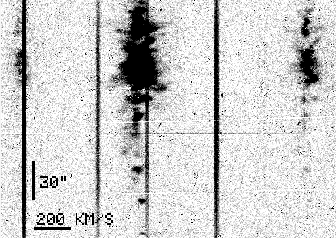


The roughly constant star formation rates over the lifetimes of irregulars (Tosi et al. 1991, Greggio et al. 1993, Marconi et al. 1995, Tolstoy 1996) implies the existence of regulatory mechanisms, probably tied to young stars and independent of individual galaxies' properties. That massive stars can have a large impact on their surroundings is coming to be more and more appreciated with time. Not only do massive stars explode as supernovae, but integrated over their lifetimes the input of mechanical energy to the ISM from their winds can be comparable to that in the supernova explosion (Leitherer, Robert, & Drissen 1992).

|

|
Figure 10. Signatures of the input of mechanical energy to the ISM
by concentrations of massive stars are illustrated with a high
dispersion echelle spectrum (bottom) and deep H image (top) of
NGC 4449
from Hunter & Gallagher
(1997). The spectrum shows the
[NII] image (top) of
NGC 4449
from Hunter & Gallagher
(1997). The spectrum shows the
[NII]  6548, H 6548, H , and [NII] , and [NII]  6584 emission-lines
and reveals the presence of high velocity ionized gas. The image shows
kpc-size H 6584 emission-lines
and reveals the presence of high velocity ionized gas. The image shows
kpc-size H |
The signatures of this energy input are abundant. In giant H II regions
in irregulars, for example, high dispersion spectra exhibit large
velocities in the ionized gas (illustrated in
Figure 10).
Hunter (1982) measured the
kinetic energy of giant H II regions in irregulars
and found that 2 x 1050 ergs was typical.
In addition H images of
irregulars reveal many shells and filaments
(Hunter & Gallagher 1990,
Hunter et al. 1993),
including supergiant filaments that can be several kiloparsecs in size
(Hunter & Gallagher 1992,
1997). One example is shown in
Figure 10. Shells and filamentary structures
are also seen in the neutral gas in H I maps of irregulars
(Puche et al. 1992,
Tongue & Westpfahl 1995) and in
the spectacular H I survey of the Milky Way by
Hartmann & Burton (1995). In one
case at least the supergiant H
images of
irregulars reveal many shells and filaments
(Hunter & Gallagher 1990,
Hunter et al. 1993),
including supergiant filaments that can be several kiloparsecs in size
(Hunter & Gallagher 1992,
1997). One example is shown in
Figure 10. Shells and filamentary structures
are also seen in the neutral gas in H I maps of irregulars
(Puche et al. 1992,
Tongue & Westpfahl 1995) and in
the spectacular H I survey of the Milky Way by
Hartmann & Burton (1995). In one
case at least the supergiant H filaments are the
ionized inner edge of a 1.8 kpc diameter H I shell
(Hunter & Gallagher 1997), and
in at least two irregulars of unusually high global star
formation rates the morphology of the H
filaments are the
ionized inner edge of a 1.8 kpc diameter H I shell
(Hunter & Gallagher 1997), and
in at least two irregulars of unusually high global star
formation rates the morphology of the H filaments suggests that
superbubbles have fragmented and cooled above the plane of the galaxy.
That these enormous H
filaments suggests that
superbubbles have fragmented and cooled above the plane of the galaxy.
That these enormous H filaments are photoionized implies that there are long lines of site
for ultraviolet photons to travel long distances
through irregulars, implying that the ISM is quite lumpy.
filaments are photoionized implies that there are long lines of site
for ultraviolet photons to travel long distances
through irregulars, implying that the ISM is quite lumpy.
Thus, the signs are there that massive stars can and do input energy to the ISM and that this input can modify their surroundings. However, the question here is whether these modifications act as a significant feedback to the cloud or star formation process. If the input from the massive stars furthers star formation, then the feedback would be positive; if it hinders further star formation, then the feedback is negative. Some examples of a positive feedback exist. Constellation III in the LMC is one such case. The enormous star formation event that produced Constellation III has blown a hole in the gas that is ~ 2 kpc in diameter. Embedded in the shell that surrounds this hole are H II regions. The implication is that in producing the H I hole, gas was compressed into the shell, clouds formed, and stars are now forming from those clouds (Dopita et al. 1985). A similar situation is seen around the large OB association NGC 206 in M31 (Brinks 1981). However, what we do not know is if this chain reaction will continue or instead end with the smaller events that constitute the second generation of star formation.
Furthermore, how effective are these isolated examples of positive feedback in driving star formation throughout the whole galaxy? Larson (1996) points out that the net effect of this feedback in galaxies must be negative because otherwise all of the gas would have been turned into starsby now. Nevertheless, star-induced star formation models with appropriately adjusted parameters have been successful in reproducing the large-scale clumping that is seen in irregular galaxies (Gerola et al. 1980, Feitzinger et al. 1981) although the physical underpinning of the model parameters is not clear. Unfortunately, making progress in understanding the effects of feedback on the global star formation activity is hampered by the fact that one must show causality, and when the timescales are long, the fragile causal connection can be lost to observations.
In summary, there is ample evidence that massive stars provide an important feedback by ``churning up'' the ISM. In small galaxies like irregulars, one might expect that this energy input could be important in facilitating further cloud formation. However, the collective impact on star formation over an entire galaxy is not yet clear.